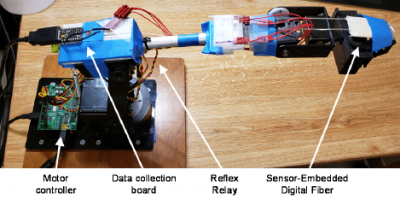
Syamantak Payra, Gabriel Loke, and Yoel Fink
Awarded Second Place Best Paper Award in the MIT IEEE Undergraduate Research Technology Conference
Abstract:
Robotic control systems have conventionally lacked context-aware sensory capabilities and rapid sensorimotor reflexes, which has limited the capability of robotic platforms to adapt to new or different environments and tasks. While nervereplicating sensors have been prototyped, low-latency reflex action is still not feasible with control systems that process sensory inputs subsequent to operational logic. We propose a robot-environment interaction protocol in which functionalized digital fibers with embedded sensors act as modular reflexogenic ‘garments’, outsourcing reflex computation to interchangeable sensory extremities and conferring artificial somatosensory reflexes to robots for effective adaptation to different tasks, target objects, environments, or use cases. By programming application-specific digital fibers with context-aware reflex thresholds, in-fiber microcontrollers can detect stimulus magnitude and generate digital interrupt signals, causing a predetermined reflex action to be activated from a central control system. As a proof of concept, digital fibers with embedded temperature sensors were used to model a “thermal glove” attachment and integrated with a 5- degree-of-freedom robotic manipulator. This prototype offers a testbed for the evaluation of reflexory function in a robot that contracts an extended manipulator arm in response to ambient or contact exposure to high temperatures, similar to the “hot stove” reflex arc of human arm motion. Even with relatively low-speed digital communications, rapid reflexory signal transmission can be achieved: while operating at I2C clock cycle speeds, sensory data collection and computation, threshold checking, and motiontriggering interrupt signal transmission can be completed up to 2 orders of magnitude faster than with conventional centralized computation of sensory inputs. With this protocol, separate sensorimotor reflexes can be added as needed with independent functionalized attachments, decreasing reflex latency and minimizing the computational load that main processors need to devote to computing sensory reflex actions. Modular sensory attachments decrease the need for complex centralized sensing systems or continuous reprogramming in preparation for separate tasks; this can reduce cost and time overhead incurred during equipment turnaround in operations leveraging robotic complements to human labor. In addition, these reflex fibers can be used to improve robotic spatial and sensory awareness and facilitate more efficient interactions with the robot’s environment, improving balance and other tactile reflexes in humanoid / agile robots and enabling more effective bionic prosthetics and bioinspired robotic platforms.
